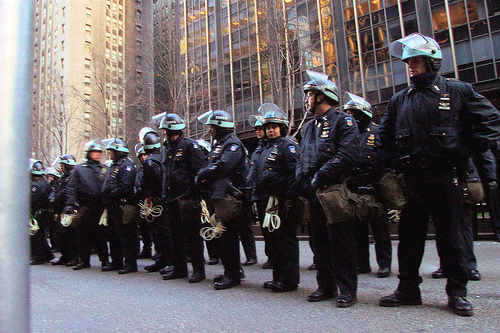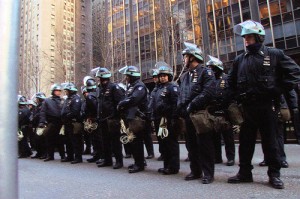
Maintaining Law and Order in Protest Movements
January 12, 2012Student Blogs Article Police intervention is society’s preferred method of maintaining law and order. As the cold weather sets in, we hear less and less about the Occupy Wall Street movements that swept the nation and the subsequent police response to it. Many observers, including the media, found the protest laudable and heavily criticized what they viewed as an overly aggressive response by the police. The police response to the protests raised some interesting questions regardless of where one lies on the political spectrum: When is police intervention required and how much force is appropriate?
Police intervention is society’s preferred method of maintaining law and order. As the cold weather sets in, we hear less and less about the Occupy Wall Street movements that swept the nation and the subsequent police response to it. Many observers, including the media, found the protest laudable and heavily criticized what they viewed as an overly aggressive response by the police. The police response to the protests raised some interesting questions regardless of where one lies on the political spectrum: When is police intervention required and how much force is appropriate?
By now, we’re all too familiar with the more infamous imagery to come out of the movement: That of the a police officer allegedly running over the leg of a National Lawyers Guild observer and of a UC Davis police officer pepper spraying a group of allegedly peaceful protesters. When these photos and videos went viral, the media generated a huge amount of publicity around the images. Amidst the anger and outrage sparked by the media frenzy, few in the public even noticed when these two incidents were discredited. In the NLG episode, there is evidence to suggest that the event was staged and the observer faked being run over by the police. In the pepper spray incident, a longer and perhaps more complete video suggests that the police reaction was not entirely unprovoked. The police were being surrounded on all sides by protesters demanding the release of two of their comrades. After the police gave numerous commands to clear a path, they finally resorted to pepper spray to clear a way through the throng and ensure their safe exit.
There are those who say that the police could have simply stepped over the students and avoided spraying them, which itself raises an interesting question. Should we require our police officers to subject themselves to these dangers? The job of a police officer is dangerous by definition, and a simple arrest can quickly turn into a more threatening situation. For example, after an NYPD officer attempted to arrest an OWS protester on New Year’s Eve, he was stabbed in the hand. Luckily the officer was treated immediately, hospitalized and released. However, incidents such as these underscore the dangers that that police face each and every day.
As a society, we have vested our security in the hands of the police and accordingly we should defer—and do defer to large extent—to their experience and on-the-scene judgments. Police are faced with many unpredictable situations. A seemingly routine police action can suddenly turn into a dangerous and life threatening situation. This is especially a concern in NYC, a city of eight million people and only around 35,000 police officers. It would be extremely difficult for the police to contain a riot if one were to erupt in a city of this size.
The Supreme Court has recognized the challenges that the police face and held that in determining whether the use of force is excessive in effectuating an arrest, courts should consider whether the use of force was objectively reasonable in “in light of the facts and circumstances confronting them, without regard to [the officers’] underlying intent or motivation.” The touchstone of the inquiry is reasonableness, requiring the courts to consider, inter alia, the threat of danger to the officer and society. Graham v. Connor, 490 U.S. 386 (1989).
We should not wait for a situation to develop before the police are allowed to act, we should instead defer to police judgment. If a decision is made that a particular protest or protestor is getting out of control, or starting to infringe on the rights of others, the police should not only be allowed but required to take whatever action is necessary to diffuse the situation or eliminate the threat to public safety.
The NYPD’s response to the OWS movement has been faulted for using certain aggressive tactics to control the protests. However, we should instead celebrate their commitment to maintaining law and order. Their hard work and dedication have ensured that the OWS movement did not spiral out of control while simultaneously protecting a city of eight million people. Even if some protestors were inadvertently injured, the officers should not be overly criticized for the actions they took. The NYPD officers made on-the-scene judgments, and it is not for us to judge the appropriateness of these actions by viewing them in hindsight.
You may also like
1 comment
- April 2024
- March 2024
- February 2024
- November 2023
- October 2023
- April 2023
- March 2023
- February 2023
- January 2023
- December 2022
- November 2022
- October 2022
- May 2022
- April 2022
- March 2022
- February 2022
- January 2022
- December 2021
- November 2021
- October 2021
- May 2021
- April 2021
- March 2021
- February 2021
- January 2021
- November 2020
- October 2020
- September 2020
- August 2020
- July 2020
- June 2020
- May 2020
- April 2020
- March 2020
- February 2020
- January 2020
- November 2019
- October 2019
- September 2019
- April 2019
- February 2019
- December 2018
- November 2018
- October 2018
- September 2018
- March 2018
- February 2018
- January 2018
- December 2017
- November 2017
- October 2017
- September 2017
- May 2017
- April 2017
- March 2017
- February 2017
- December 2016
- November 2016
- October 2016
- April 2016
- March 2016
- February 2016
- January 2016
- December 2015
- November 2015
- October 2015
- June 2015
- May 2015
- April 2015
- March 2015
- February 2015
- January 2015
- December 2014
- November 2014
- October 2014
- August 2014
- March 2014
- February 2014
- January 2014
- December 2013
- November 2013
- October 2013
- September 2013
- May 2013
- April 2013
- March 2013
- February 2013
- January 2013
- December 2012
- November 2012
- October 2012
- September 2012
- June 2012
- April 2012
- March 2012
- February 2012
- January 2012
- December 2011
- November 2011
- October 2011
- September 2011
- August 2011
- April 2011
- March 2011
- November 2010
- October 2010
- September 2010

While I’m no fan of egregious police behavior, I have to agree with this article. Many news reports about OWS (among other protests) seem to lionize protesters and shield them from critique when, at least in my opinion, police are sometimes justified in what may appear to be over-the-top tactics and methods. Police officers are often put in positions where they have to pick the lesser of two evils (or, more often, the most effective form of harm prevention), and the result is rarely as clean or as pretty as one would like in hindsight.
Gary A. Klein has done some fascinating studies illustrating how decisionmakers (in one of his studies, firefighters) use a Recognition Primed Decision (RPD) model to make decisions in times of stress. In short, RPD models indicate that decisionmakers like police officers under stress tend to take the first method that seems to “fit” a series of constraints without fully addressing all possible alternatives. If we are to believe Klein’s research is correct, it may be inappropriate to say that many police decisions are inherently wrong for the situation, as they (like many other humans) will take the first easy, yet perhaps incorrect, choice that comes to mind that will quickly remedy a perceived impending danger. Judging police officers from the lofty comfort of a journalist’s desk ex post facto may thus be unwarranted without a good reason.